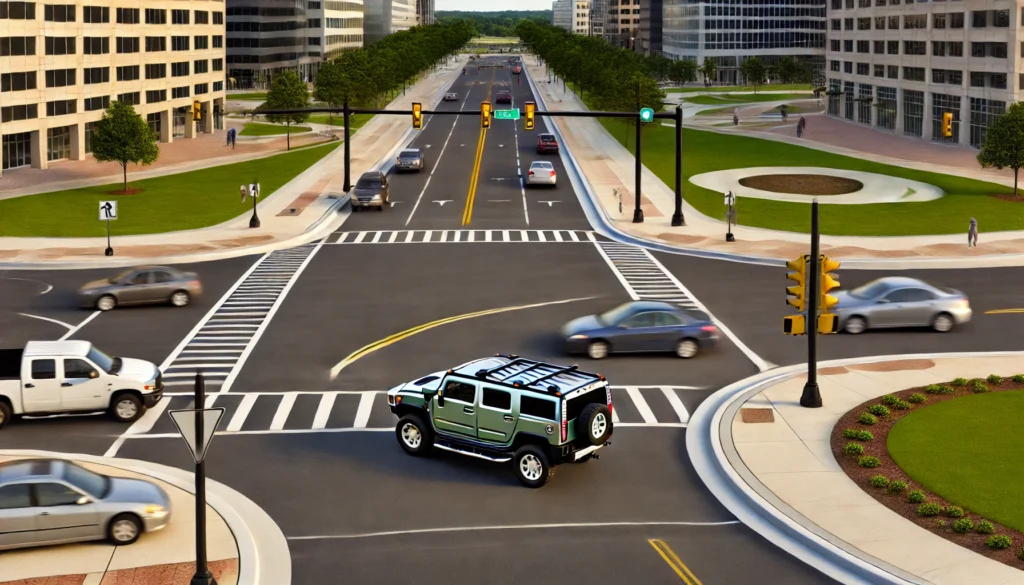Table of Contents
ToggleIntroduction
As urban areas continue to expand and traffic congestion becomes an ever-growing concern, urban planners and engineers are in constant pursuit of innovative solutions to enhance traffic flow and safety. One such groundbreaking solution is the Continuous Flow Intersection (CFI). In Virginia, where roadways are increasingly strained by daily commuter traffic, CFIs have garnered widespread attention for their efficiency and effectiveness. Furthermore, the intersection’s ability to accommodate large vehicles like the 2014 Hummer has become a subject of interest and discussion.
This comprehensive analysis delves into the workings of CFIs, their growing adoption in Virginia, and the performance of larger vehicles, particularly the 2014 Hummer, in these innovative road designs. By the end of this article, you’ll gain a nuanced understanding of how the Virginia News Continuous Flow Intersection 2014 Hummer highlights the intersection of infrastructure planning and vehicular needs in modern urban environments.
What is a Continuous Flow Intersection (CFI)?
A Continuous Flow Intersection (CFI) is an advanced road design aimed at reducing traffic delays, congestion, and potential accidents. Unlike traditional intersections, where vehicles often come to a halt for traffic lights to change, CFIs streamline vehicle movement by eliminating the need for vehicles to wait at the main intersection for certain maneuvers, particularly left turns. In a CFI, vehicles intending to turn left cross oncoming traffic before reaching the main intersection, allowing for a smoother and more efficient flow.
The design is particularly useful in areas with high traffic volumes, where traditional intersections can become bottlenecks. By preemptively facilitating left turns, CFIs reduce the number of signal phases needed to manage traffic, thereby minimizing delays and enhancing overall intersection throughput.
The Rise of CFIs in Virginia: Addressing Traffic Challenges
Virginia has always been at the forefront of infrastructure innovation, implementing road systems designed to adapt to increasing urbanization and traffic demands. As population growth intensifies in Virginia’s urban centers, the state has explored diverse traffic management solutions. The Continuous Flow Intersection has emerged as a significant component of this strategy, introduced to improve efficiency on the state’s busiest roadways.
In cities such as Fairfax, Richmond, and Norfolk, where peak-hour traffic congestion poses daily challenges, CFIs have proven to be effective. Local news outlets, including the Virginia News Network, have highlighted the success of these intersections, emphasizing their contribution to smoother commutes, reduced travel times, and improved safety.
Navigating CFIs: The Mechanics of Improved Traffic Flow
The primary goal of CFIs is to facilitate left-turn maneuvers without disrupting the continuous flow of traffic. In traditional intersections, left turns often require separate signal phases, causing vehicles to idle and contributing to congestion. CFIs resolve this issue by shifting the left-turn process to an earlier point on the roadway, thereby allowing for simultaneous movement of vehicles in different directions.
Here’s how a CFI operates in practice:
- Preemptive Left-Turn Lanes: Vehicles intending to make a left turn are directed into designated left-turn lanes several hundred feet before the main intersection. These lanes cross oncoming traffic through a signal-controlled crossover section.
- Elimination of Left-Turn Signals: Once the vehicles have crossed into the designated left-turn area, they wait for their turn to merge into the flow of the main intersection. This setup eliminates the need for separate left-turn signals at the intersection itself, significantly reducing delays.
- Enhanced Intersection Throughput: By removing the traditional left-turn signal phase, the intersection can handle more traffic in a given time, improving the overall flow and reducing congestion during peak hours.
- Improved Safety: CFIs are designed to reduce conflict points between vehicles, particularly where left-turning vehicles typically intersect with oncoming traffic. This design minimizes the likelihood of accidents, making intersections safer for all road users.
The 2014 Hummer: A Vehicle of Distinction in Urban Traffic

The 2014 Hummer is known for its rugged build, off-road capabilities, and substantial size. Its imposing dimensions have often made navigating through tight urban spaces a challenge. The vehicle’s turning radius, length, and width require careful planning and maneuvering in traditional road settings. These characteristics make it an interesting focal point for assessing the effectiveness of CFIs, which aim to accommodate a wide variety of vehicle types.
Drivers of the 2014 Hummer often face difficulties when making sharp turns or merging in congested city streets, a problem that traditional intersections exacerbate. CFIs, with their preemptive left-turn lanes and wider approaches, offer a solution. The ease with which the 2014 Hummer navigates CFIs showcases these intersections’ capacity to handle not only regular commuter cars but also larger, more cumbersome vehicles.
Virginia News and the Continuous Flow Intersection: Highlighting the 2014 Hummer
News outlets in Virginia have extensively covered the implementation of CFIs and their impact on local traffic. Reports frequently cite the Virginia News Continuous Flow Intersection 2014 Hummer case as a prime example of how CFIs accommodate large vehicles. Early concerns from the driving community revolved around whether oversized vehicles, like the 2014 Hummer, would be able to navigate CFIs effectively.
Coverage from local news has highlighted numerous instances where drivers of large vehicles found CFIs easier to navigate than traditional intersections. Testimonies from Hummer owners underscore the intersection’s capacity to handle their vehicles smoothly, especially when making left turns. The news coverage indicates that CFIs are not only advantageous for smaller, agile cars but also cater to the needs of SUVs and trucks, thereby enhancing the overall efficiency and safety of urban road networks.
Benefits of Continuous Flow Intersections for Large Vehicles Like the 2014 Hummer
The Virginia News Continuous Flow Intersection 2014 Hummer case sheds light on several advantages that CFIs provide for larger vehicles:
- Wider Turning Lanes: CFIs are designed with wider lanes to accommodate the increased turning radius of larger vehicles. For the 2014 Hummer, this means it can make left turns without encroaching on adjacent lanes or causing traffic obstructions.
- Reduced Wait Times: In a traditional intersection, a vehicle as large as the Hummer might have to wait through multiple signal phases to complete a left turn safely. CFIs eliminate this delay by allowing preemptive left turns, reducing idle times and enhancing fuel efficiency.
- Enhanced Traffic Flow: By allowing continuous movement for left-turning vehicles, CFIs improve overall traffic flow. This benefit is particularly noticeable for larger vehicles, which can often become bottlenecks in conventional intersections.
- Improved Safety: Larger vehicles face a higher risk of collisions when crossing multiple lanes of traffic. CFIs minimize this risk by separating left-turning vehicles from oncoming traffic lanes, providing a designated space for safe crossing.
Addressing Challenges: Optimizing CFIs for All Drivers
Despite the many benefits, the Virginia News Continuous Flow Intersection 2014 Hummer analysis also points to certain challenges. The primary concern is the learning curve associated with navigating CFIs. Because the design differs significantly from traditional intersections, drivers unfamiliar with CFIs might experience confusion during their first encounters.
To mitigate this, Virginia’s transportation authorities have launched educational campaigns, utilizing clear signage and instructional videos to familiarize drivers with the layout and operation of CFIs. Ensuring that all drivers, regardless of vehicle size, understand how to use CFIs is crucial for maximizing their benefits.
Additionally, while CFIs are generally designed to accommodate large vehicles, some intersections may face space constraints. In densely built urban areas, where road expansion is not feasible, authorities may need to explore alternative modifications to ensure that even oversized vehicles like the 2014 Hummer can navigate CFIs efficiently.
Future Prospects and Innovations in Intersection Design
The success of CFIs in Virginia has sparked discussions about further improvements and potential new designs for managing urban traffic. Future advancements may include smart traffic signals that adjust in real-time to traffic volumes, offering more dynamic control over vehicle movement. Moreover, integrating CFIs with other intelligent traffic management systems, such as adaptive cruise control and vehicle-to-infrastructure communication, could optimize intersection efficiency even further.
For large vehicles like the 2014 Hummer, emerging technologies such as augmented reality (AR) navigation aids and vehicle sensors could assist drivers in maneuvering through complex intersections with greater ease. These developments would further enhance the compatibility of CFIs with a diverse range of vehicles on the road.
Conclusion
The story of the Virginia News Continuous Flow Intersection 2014 Hummer exemplifies the potential of innovative infrastructure to improve urban mobility for all vehicle types. By prioritizing continuous traffic flow and reducing conflict points, CFIs have transformed intersections from sources of congestion into facilitators of efficient and safe travel.
The experience of navigating CFIs in a vehicle as large as the 2014 Hummer underscores their adaptability and effectiveness in managing modern traffic challenges. As cities grow and roadways become increasingly congested, the success of CFIs in Virginia provides a blueprint for other regions seeking to enhance their traffic management systems.
In summary, the Continuous Flow Intersection represents a critical evolution in urban planning, blending advanced design principles with practical solutions to create a more seamless driving experience. As we look to the future, continued innovation in intersection design, paired with the integration of new vehicle technologies, promises to further refine and optimize the flow of urban traffic, benefiting drivers of all vehicle sizes. The 2014 Hummer’s effortless navigation through Virginia’s CFIs serves as a compelling testament to this progress.
Read More: Rank-by-ping.com




